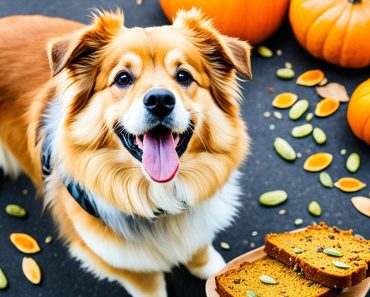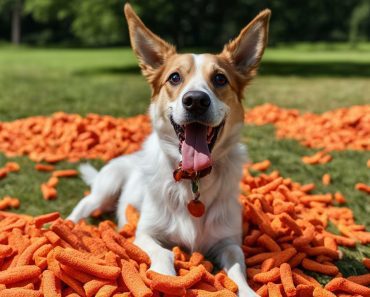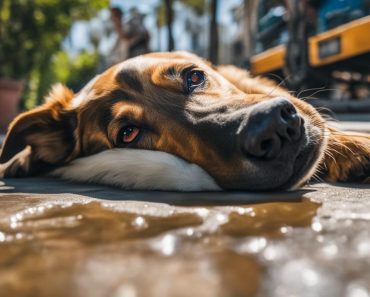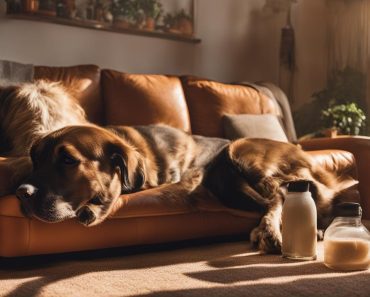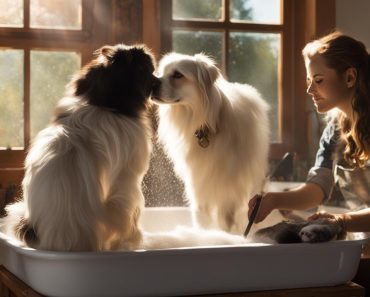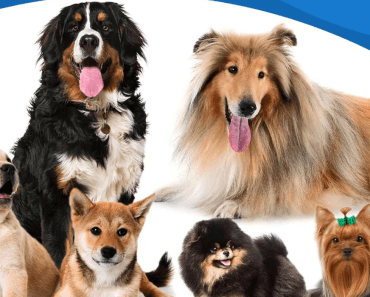Great Danes are truly magnificent creatures; gentle giants with a rich history and a reputation for their impressive size and kind temperament. However, owning a Great Dane comes with its fair share of challenges. It’s important for Great Dane owners like me to be aware of the common health and behavior problems that can affect our beloved pets.
When it comes to their health, Great Danes are prone to certain issues due to their large size and specific physical characteristics. Some of the common health problems that Great Danes may face include gastric dilatation volvulus (GDV), hip dysplasia, ear infections, wobbler syndrome, dilated cardiomyopathy, bloat, and happy tail syndrome. These conditions require proper attention and proactive measures to ensure the well-being of our furry friends.
Aside from health concerns, Great Danes can also experience behavioral issues and training challenges. They are highly sociable dogs that can develop separation anxiety if not properly socialized and trained. Great Danes may also exhibit stubbornness during training, but with patience, consistency, and positive reinforcement methods, they can become well-behaved companions.
Grooming and exercise are also important aspects of caring for a Great Dane. While their grooming needs are relatively low, regular brushing and ear cleaning are necessary to maintain their coat’s health and prevent infections. As for exercise, Great Danes have moderate needs and require daily walks or playtime to keep them physically and mentally stimulated.
As a proud owner of a Great Dane, I understand the challenges and responsibilities that come with this magnificent breed. By staying informed about the common health and behavior problems, providing proper care and nutrition, and seeking the necessary support from veterinarians and trainers, we can ensure that our Great Danes lead happy and healthy lives.
Key Takeaways:
- Great Danes are prone to health problems such as GDV, hip dysplasia, and ear infections.
- Proper socialization and training are essential to prevent behavioral issues in Great Danes.
- Regular grooming and exercise are necessary for the well-being of Great Danes.
- Providing a balanced diet and seeking veterinary care are crucial for maintaining a Great Dane’s health.
- By being informed and proactive, we can ensure the happiness and well-being of our Great Danes.
Health Problems in Great Danes
Great Danes, despite their majestic stature, are not immune to health concerns. As a responsible owner, it’s essential to be aware of the common health problems that can affect these gentle giants.
One of the most critical health concerns in Great Danes is gastric dilatation volvulus (GDV), commonly known as bloat. This life-threatening condition primarily affects deep-chested dogs like Great Danes. Bloat occurs when the stomach fills with air or gas and twists. If not promptly treated, GDV can lead to severe complications and even death.
Another prevalent health issue in Great Danes is hip dysplasia, a condition characterized by the abnormal development of the hip joint. This can result in pain, lameness, and arthritis. Regular screening and early intervention can help manage this condition effectively.
Wobbler syndrome, also known as cervical spondylomyelopathy (CSM), is another concern for Great Dane owners. This neurological condition affects the spine, leading to weakness, uncoordinated movements, and neck pain. Diagnostic imaging and medical management are crucial for improving the quality of life for affected dogs.
Dilated cardiomyopathy (DCM) is a heart condition that commonly affects Great Danes. It causes the heart muscle to become weak and enlarged, leading to potential heart failure. Regular cardiac evaluations and appropriate treatment can help manage DCM and prolong the lifespan of affected dogs.
Finally, Great Danes are prone to a condition known as happy tail syndrome, where the tail repeatedly strikes hard surfaces, leading to open wounds and infections. This can be challenging to treat and may require preventive measures such as tail bandaging or protective barriers.
It’s important for Great Dane owners to be familiar with the signs and symptoms of these health problems to ensure early detection and proper veterinary care. Regular check-ups, a nutritious diet, and an active lifestyle can all contribute to the overall well-being of these magnificent dogs.
Dietary Concerns for Great Danes
Proper nutrition plays a vital role in maintaining the overall health and well-being of Great Danes. As a large breed, Great Danes have specific dietary needs that should be carefully addressed. Feeding them a high-quality dog food specially formulated for large breeds is essential. These specially formulated diets provide the right balance of nutrients to support their unique requirements.
When choosing a commercial diet for your Great Dane, opt for one that is designed specifically for large-breed dogs. These diets are formulated to meet the nutritional needs of larger dogs, taking into account their size, growth rate, and potential health concerns. Look for a product that has high-quality protein sources, moderate fat levels, and controlled calcium and phosphorus content.
Following the recommended feeding guidelines is vital for ensuring your Great Dane receives optimal nutrition. Overfeeding can lead to obesity, which can exacerbate certain health issues common in Great Danes, such as hip dysplasia and other joint problems. Monitoring your dog’s body condition score regularly can help you assess their weight and adjust their diet accordingly.
For growing Great Dane puppies, it’s important to provide them with a large-breed puppy diet. These diets are formulated to support proper growth and development while minimizing the risk of orthopedic diseases, including hip dysplasia. They contain precise ratios of nutrients, such as calcium and phosphorus, to promote healthy bone and joint formation.
In addition to a balanced diet, some Great Danes may benefit from joint supplements containing ingredients like glucosamine and chondroitin. These supplements can help support joint health and mobility, which is important for a large and active breed like the Great Dane.
Proper nutrition is key to maintaining the overall health and well-being of your Great Dane. By providing them with a well-balanced diet, following feeding guidelines, and considering their specific dietary needs, you can help prevent common dietary issues and ensure your Great Dane thrives.
Key points:
- Choose a high-quality dog food specially formulated for large breeds.
- Follow feeding guidelines and monitor your Great Dane’s body condition score.
- Consider a large-breed puppy diet to promote proper growth and development.
- Joint supplements with glucosamine and chondroitin may benefit some Great Danes.
Behavioral Issues and Training Challenges in Great Danes
While Great Danes are generally known for their gentle and friendly nature, they can also experience behavior problems if not properly socialized and trained. One common issue that Great Danes may face is separation anxiety due to their strong bond with their owners. This can result in behaviors such as excessive barking, destructive chewing, and attempting to escape.
Proper socialization from an early age is crucial to prevent anxiety, fearfulness, and aggression in Great Danes. Exposing them to various environments, people, and other animals will help them develop into well-adjusted and confident dogs. Additionally, positive reinforcement training methods should be used to encourage good behavior and discourage unwanted behaviors.
Great Danes can sometimes be stubborn during training, which can present challenges for their owners. However, with patience, consistency, and positive reinforcement, they can learn quickly and become well-behaved companions. It’s essential to establish yourself as a strong and consistent leader for your Great Dane, as they respond well to clear boundaries and expectations.
Working with a Professional Trainer
Working with a professional dog trainer who has experience with large breeds like Great Danes can be highly beneficial. They can provide guidance and expertise in addressing specific behavior problems and tailoring training methods to suit your Great Dane’s needs. Obedience classes can also offer a structured environment for socialization, training, and interaction with other dogs.
Dealing with Separation Anxiety
Separation anxiety can be a challenging issue for Great Dane owners. To help alleviate this problem, it’s important to gradually desensitize your dog to your departures and create a calm and positive environment when you leave. Providing them with interactive toys, leaving a radio or TV on for background noise, and using pheromone diffusers or calming sprays can also help reduce their anxiety.
Remember that every dog is unique, and it may take time and patience to address behavior issues and training challenges in Great Danes. With the right approach, understanding, and consistent training, you can help your Great Dane become a well-mannered and happy member of your family.
Grooming and Exercise Needs of Great Danes
Despite their size, Great Danes have relatively low grooming needs. Their short coats require regular brushing to remove loose hair and keep the coat healthy. Brushing also helps in preventing matting and shedding. Great Danes are generally clean dogs and only require occasional bathing. However, it’s important to pay attention to their ears and clean them regularly to prevent infections. Use a dog-friendly ear cleaning solution and gently wipe the ears with a cotton ball or a soft cloth.
As for exercise, Great Danes have moderate exercise needs. While they are not highly energetic dogs, they still need daily walks or playtime to keep them physically and mentally stimulated. Going for walks provides them with the opportunity to explore their surroundings and sniff around. It’s important to remember that Great Danes are prone to joint problems, so avoid high-impact activities like jumping and running on hard surfaces. Instead, opt for low-impact exercises like swimming or controlled play sessions. It’s crucial not to over-exercise growing Great Dane puppies to avoid potential joint problems later in life.
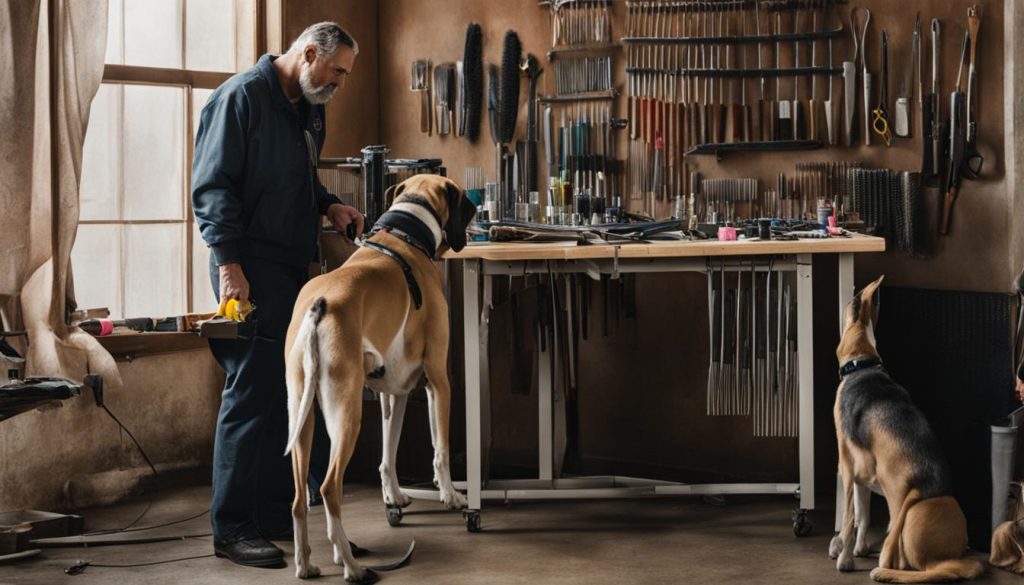
Conclusion
As owners of magnificent Great Danes, it’s crucial for us to be aware of the health and behavioral challenges that these gentle giants may face. Regular veterinary check-ups and preventive care are essential to address any potential problems and maintain their well-being. By providing proper training and socialization from an early age, we can help our Great Danes develop positive behaviors and overcome any temperament issues that may arise.
In addition, a balanced diet tailored to their specific needs, along with regular exercise, will contribute to their overall health and happiness. Great Danes have relatively low grooming needs but don’t forget to regularly brush their coat and clean their ears to prevent any discomfort or infections. These small grooming tasks play a big role in keeping our Great Danes looking and feeling their best.
By staying informed, proactive, and attentive to the needs of our Great Danes, we can provide them with the love, care, and support they require. Despite the challenges that may come our way, our efforts will ensure that our Great Danes lead fulfilling lives as beloved family members and cherished companions.
FAQ
What are the common health problems in Great Danes?
Common health problems in Great Danes include gastric dilatation volvulus (bloat), hip dysplasia, wobbler syndrome, dilated cardiomyopathy (DCM), and happy tail syndrome.
What dietary concerns should I have for my Great Dane?
Great Danes have specific dietary needs and should be fed a high-quality dog food specially formulated for large breeds. Feeding guidelines should be followed to prevent obesity, and large-breed puppy diets can help minimize the risk of orthopedic diseases like hip dysplasia. Joint supplements may also support their joint health.
What behavioral issues and training challenges are common in Great Danes?
Separation anxiety is a common issue in Great Danes. Proper socialization from an early age is crucial to prevent anxiety, fearfulness, and aggression. Great Danes can also be stubborn during training, but with patience, consistency, and positive reinforcement methods, they can become well-behaved companions.
What are the grooming and exercise needs of Great Danes?
Great Danes have relatively low grooming needs. They require regular brushing, occasional bathing, and ear cleaning to prevent infections. In terms of exercise, they have moderate needs and should have daily walks or playtime to keep them physically and mentally stimulated.

